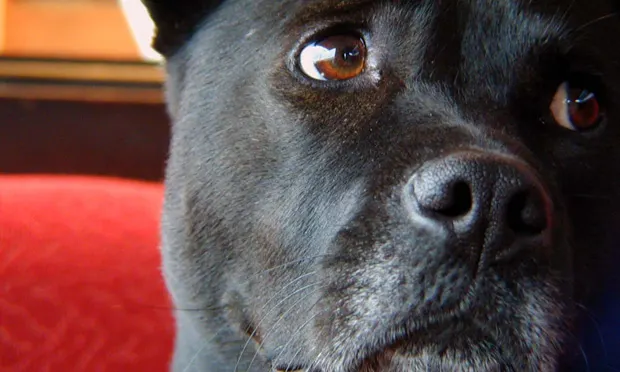How to Recognize and Treat Anxious Dogs and Cats

Editor’s note: This article has been adapted from Canine Anxiety, published in the November 2013 issue of Clinician’s Brief.
Dogs and cats commonly exhibit anxiety and fearful behaviors that often manifest as separation anxiety, storm and noise phobias, or aggression.
A short-term stress response is healthy because the animal is alert and ready to take action, such as retreating from a stranger. However, prolonged stress, such as season-long storm phobias, can result in physical and emotional pathologic conditions and potentially shorten the patient’s lifespan.1
Chronic stress may manifest itself as immunosuppression that can lead to recurring infections, or altered blood flow that may lead to problems such as gastric ulcers.2,3
Related Articles: Stress-Free Restraints and Handling
Recognizing Anxiety
The veterinarian or team member examining the patient should first carefully watch the pet’s behavior. Fear is presumed to exist when an animal exhibits specific behaviors, including vigilance, scanning, hiding, increased motor activity, pacing, panting, crying, whining, shaking, lip-licking, and yawning.4,5
Treatment
Regardless of the anxiety-related problem, behavior modification will top the list of treatment options. Three behavior modification methods are commonly used to treat anxiety and fear in dogs and cats: avoidance, desensitization and counter-conditioning, and classical conditioning or response substitution.6
Avoiding the anxiety-provoking trigger is very important, especially in the early stages of treatment. For example, if a dog lunges, barks, or growls every time he or she encounters people or other dogs on a walk, the client needs to stop taking the dog for walks, because the patient’s aggressive behavior is reinforced each time. Give the client “permission” to do something else with his or her dog, such as agility training in the backyard.
Related Article: How to Become a Veterinary Behavior Technician
Desensitization occurs when the patient is exposed to a stimulus at such a low level that the anxious response is not elicited. The stimulus is repeated and the intensity increased gradually so that it does not cause anxiety, and the patient learns to relax when a previously scary stimulus is present. For example, if a dog reacts to strangers, start with a stranger close enough so the dog knows he or she is there, but far enough away that the dog does not react. Slowly decrease the distance between the dog and the stranger, ideally by having the dog approach. The dog learns not only that nothing bad happens in a stranger’s presence but also that good things, such as the stranger patting the dog, may actually happen.
Classical conditioning can be used to teach a dog or cat to relax when the scary stimulus is present. The stimulus is paired with an overwhelmingly desirable reward—really yummy treat, special toy, etc.—whether or not the pet is relaxed. The end result:
Thunder = String Cheese Stranger = Liverwurst.
Clients often have problems with classical conditioning because they think their pet is “rewarded for the undesirable behavior,” but this is not the case. The goal is to change the behavior. Fluffy cannot hiss if she is eating chicken, and Toby cannot hide and shake if he is eating cheese. Once the behavior sequence is changed, other learning (ie, relaxation) can take place.
Do not use flooding, where an animal is deliberately exposed to a stimulus at maximum intensity until the he or she stops reacting. A flooding session, which must be continued until the undesired response ceases no matter how long it takes, is dangerous, because the animal may harm him- or herself or the environment, or have an intense stress response that compromises his or her health. This technique can result in “learned helplessness,” where the patient shuts down because he or she realizes that all efforts to escape the stimulus are thwarted.
Related Article: How to Restrain Pets Appropriately in Front of Clients
Medical Therapy
Anxiolytic medications can facilitate the behavior modification that must take place when treating a fearful patient. An anxious, reactive dog or cat will have difficulty learning new things.
A pet who is anxious in a number of situations and/or during a large portion of its day likely will benefit from a maintenance medication (eg, fluoxetine, clomipramine, buspirone) used alone, or together with a fast, short-acting medication, such as a benzo-diazepine. For patients who are more contextually anxious or fearful, such as during storms or fireworks, or when the grandchildren visit, etc., the short-acting benzodiazepines can be used alone successfully.7-9
Alternative Therapies
Dog-appeasing pheromone (Adaptil) and Feliway can be beneficial when treating anxious dogs10-14 and cats,15-17 respectively.
Burning essential oil of lavender or applying it to a bandana or bedding can help decrease anxiety, particularly during car rides.18
Tablets with a blend of Magnolia officinalis and Phellodendron amurense extracts (Harmonease) can help dogs, especially during storms.19
NurtureCALM pheromone collars can be used in cats.20
Acupuncture can be an effective primary or adjunctive therapy depending on the severity of clinical signs, although there are no published studies to date.
Wraps such as the Storm Defender Cape, Thundershirt, and Anxiety Wrap can help dogs with storm phobias and separation anxiety.21,22
Whichever treatment is used, remember that fearful behavior is common in both dogs and cats.